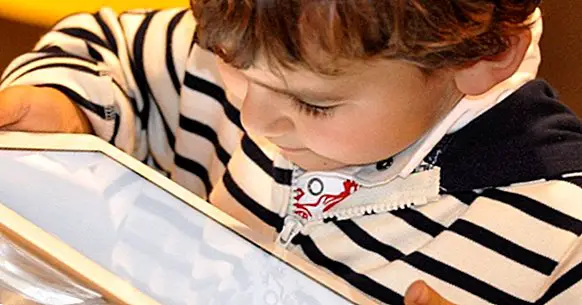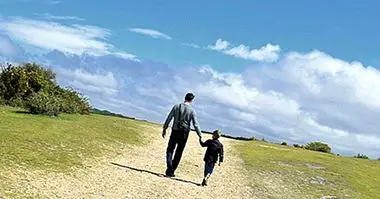Computing for children: 12 tricks to teach them how to use a PC
We live in a highly computerized world, and although those of us who were born in the 1990s or earlier have lived through a period in which these technologies were not yet widespread, today's children come to the world practically with them under their arms.
These are digital natives, who from the earliest childhood have access to a large number of possibilities derived from the use of new technologies (something that on the one hand has positive effects but at the same time also has not so favorable and even dangerous repercussions) .
But the truth is that although the use of computers is highly widespread, even those born today need someone to teach them how to use it responsibly: us. That is why throughout this article let's talk about computer science for children , and various tricks or tips from which to help them learn to use a computer.
- Related article: "Educational psychology: definition, concepts and theories"
Some tips to teach computer science for children
We'll see now some tips to help you bring children to the computer , so that they can learn to use a PC. Of course, we must take into account that depending on the age, the level of development or even the interests of the child the way and pace of learning can vary greatly.
1. Start with the basics: present the computer and the different components
Perhaps this advice may seem obvious and even stupid, but many people assume that any child already knows and understands directly what a computer is. And as with adults, there is great variability in what refers to prior knowledge.
Before moving on to assess how to use it it is necessary for children to understand what a computer, a mouse, or a keyboard is . Also what is its utility and what it is that allows us to do, and basic measures of handling and care of the material (for example not throwing water on it).
2. Uses language appropriate to their age and level of comprehension
We must not forget that we are talking about children, with what ability to understand details and technical elements will be generally lower than that of an adult with computer skills. It is necessary to adjust the type of language : it may be necessary to use analogies and comparisons with elements that children know about their day to day and gradually integrate new knowledge.
3. Entrénales in the use of mouse and keyboard
Something very basic that children should start learning in order to be able to successfully use a computer is to use the main instruments that help us to control it: mouse and keyboard.
Keep in mind that depending on the age at which they are taught to handle them Motor control can be more or less accurate . In this sense we can show you how to move the mouse allows us to move the cursor on the screen, then teach how to click with it. It is possible that this could become, at least at the beginning, a small game for the child.
As far as the keyboard is concerned, knowing how to use it requires first understanding the alphabet and showing how each key generates a different letter, symbol or number. It is useful to start with the letters and / or numbers that the child knows, in order to gradually enlarge the use of the rest of the keyboard.
Other key keys to show them are space, Enter and Escape. Keep in mind that learning to use the keyboard is a process that does not take place in a day: we should not saturate the child if we see that he is overwhelmed , because although an adult accustomed to using it may seem logical to someone who has never used it, it can be a challenge.
- Maybe you're interested: "The psychology behind social networks: the unwritten code of behavior"
4. Start using a program
Another one of the first steps that someone who begins with the computer science must dominate is the concept of program or application, as well as the fact to learn to open it and to close it. In this sense first We will have to define the concept and teach the child to look for it on the computer .
Later we have to make him understand that these programs can be opened and closed, and also that what they do can be saved. Little by little, we are going to show you these operations and help them do them themselves.
5. Encourage drawing with Paint
Many children love to draw. In this sense, programs such as Paint can be very useful in favoring and increasing the child's ability to apply prior knowledge, at the same time increases the skill with which the mouse and keyboard are used . We can also download an image that the child can follow.
6Install and use educational games
Learning to use a computer does not have to be heavy and boring. It may be useful to install different types of games available on the Internet or purchased , often with themes and characters from series known to them or generated for the purpose of favoring the learning of computer use.
It must be taken into account that there are also educational games that allow the child not only to have fun and learn to use the PC but also to increase their level of knowledge or ability in areas such as the detection and monitoring of specific stimuli, concentration, accuracy in motor control or the use of language or mathematics.
7. Use the word processor
One way in which children can learn to use the keyboard and at the same time to use one of the most common uses that we give to a computer is to teach them to open and use a word processor, such as Microsoft Word or even Notepad .
In this sense we can propose that you write your name, an object, color or favorite animal or tell us how your day has gone and try to write it with our help. If it is a little older we can propose that you write a letter or a congratulation.
8. Explore with them
Perhaps one of the most important tips is the fact that children's learning of computers will be of higher quality the more they are shared with the reference figure.
Helping them explore the field of computer science will not only allow us to show them how to use a computer itself: we are showing something new and unknown, in such a way that it can become a small adventure at the same time generates an interaction that allows to strengthen the interpersonal bond with them . It also allows the child to see how the reference figure interacts with information technology.
9. Set limits
Computer science is a very useful tool, but as we all know it also has its risks and drawbacks. It is necessary to establish limits regarding what can and can not be done with the computer, as well as how long they can be with it. Beyond these limits it may be necessary to install some type of parental control to prevent access to content inappropriate for their age, or to come in contact with unknown persons.
10. Use the Internet
Sooner or later the children will have to learn to use the network. In this sense it is necessary to make them understand not only what is but their potential uses and risks, and it is advisable to have installed some kind of filter or parental control that prevents access to bad websites. To learn how to use it It may be useful to explain what a browser or a search engine is , and use some of their hobbies to search the Internet.
11. Explain the risks
Another aspect to take into account is the need to explain to children not only the advantages of using new technologies, but also their risks: if they do not know that their use has certain dangers, it will be difficult for them to use strategies to prevent them. It is not a question of frightening them, but of making them see that we must be careful with the use of new technologies.
12. Make the experience fun
Finally, a fundamental advice for a child to interact positively with computer science is the fact that it considers the learning of its use as something desirable, fun and that implies a positive contact with its referents.
This will encourage the young person to learn , whereas on the contrary if we are critical with their abilities or we try to force them to learn to do things at a rhythm and in a concrete way it will be quite probable that they end up rejecting not only the use of the computer but also our indications (and warnings) about.
Bibliographic references:
- UNESCO (2006). International Standard Classification of Education. ISBN 92-9189-037-5.



















